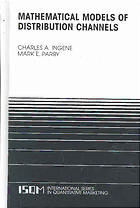Table Of ContentMATHEMATICAL MODELS OF
DISTRIBUTION CHANNELS
INTERNATIONAL SERIES
IN QUANTITATIVE MARKETING
Series Editor:
Jehoshua Eliashberg
The Wharton School
University of Pennsylvania
Philadelphia, Pennsylvania USA
Other books in the series:
Chakravarty, A. and Eliashberg, J.
Managing Business Interfaces:
Marketing,Engineering, and Manufacturing Perspectives
Zaccour, G.
DifferentialGames in Marketing
Wind, Yoram (Jerry) and Green, Paul E.
Marketing Research and Modeling:
Progress and Prospects
Erickson, Gary M.:
Dynamic Models of Advertising Competition, Ed
Hanssens, D., Parsons, L., and Schultz, R.:
Market Response Models:
Econometric and Time Series Analysis, Ed
Mahajan, V., Muller, E. and Wind, Y.:
New-Product Diffusion Models
Wierenga, B. and van Bruggen, G.:
Marketing Management Support Systems:
Principles, Tools, and Implementation
Leeflang, P., Wittink, D., Wedel, M. and Naert, P.:
Building Models for Marketing Decisions
Wedel, M. and Kamakura, W.G.:
Market Segmentation, 2nd Ed
Wedel, M. and Kamakura, W.G.:
Market Segmentation
Nguyen, D.:
Marketing Decisions Under Uncertainty
Laurent, G., Lilien, G.L., Pras, B.:
Research Traditions in Marketing
Erickson, G.:
DynamicModels of Advertising Competition
McCann, J. and Gallagher, J.:
Expert Systems for Scanner Data Environments
Hanssens, D., Parsons, L., and Schultz, R.:
Market Response Models:
Econometric and Time Series Analysis
Cooper, L. and Nakanishi, M.:
Market Share Analysis
MATHEMATICAL MODELS OF
DISTRIBUTION CHANNELS
by
Charles A. Ingene
University of Mississippi
Mark E. Parry
University of Virginia
KLUWER ACADEMIC PUBLISHERS
NEW YORK,BOSTON, DORDRECHT, LONDON, MOSCOW
eBookISBN: 0-387-22790-3
Print ISBN: 1-4020-7163-9
©2005 Springer Science + Business Media, Inc.
Print ©2004 Kluwer Academic Publishers
Boston
All rights reserved
No part of this eBook maybe reproducedor transmitted inanyform or byanymeans,electronic,
mechanical, recording, or otherwise, without written consent from the Publisher
Created in the United States of America
Visit Springer's eBookstore at: http://ebooks.kluweronline.com
and the Springer Global Website Online at: http://www.springeronline.com
Dedications:
To my wife and son, Daphne and Ulysses
Charles A. Ingene
To my father and mother, Arthur and Patricia
Mark E. Parry
Contents
Preface xxi
1In the Beginning xxi
2Toward a Unifying Theory of Distribution Channels xxii
3Channel Myths and Distribution-Channels Modeling xxiii
4Academic Study xxiv
1 A Commentary on Distribution-Channels Modeling 1
1Introduction 1
2ChannelMyths 8
3Our Fundamental Assumptions 12
4Our Plan for the Monograph 17
5Introductory Commentary 22
6Appendix 23
2 The Bilateral-Monopoly Model and Channel Myths 29
1Introduction 29
2The Bilateral-Monopoly Model: The Early Literature 30
3The Bilateral-Monopoly Model: Formal Analyses 34
4Key Channel Myths Illustrated 48
5Commentary 67
Channels without Competition 71
3 Multiple (Exclusive) Retailers 75
1Introduction 75
2The Vertically-Integrated System 77
3Channel Coordination with Independent Retailers 83
4Manufacturer Profit-Maximizationwith Independent Retailers 92
5Commentary 107
6Appendix 111
4 Multiple (Exclusive) States-of-Nature 115
1Introduction 115
2Assumptions of the Model 118
3The Vertically-Integrated System 119
4An Independent Retailer 129
5The Channel-Coordinating Tariffs 133
6The Stackelberg Tariffs 151
7Coordination vs. Maximization 164
8Commentary 180
Channels with Competition 191
5 Toward a Manufacturer-Optimal Per-Unit Fee:
A Channel-Coordinating Quantity-Discount Schedule 195
1Introduction 195
2The Model’s Assumptions 198
3The Vertically-Integrated System 198
4Independent Retailers and a Quantity-Discount Schedule 202
5Independent Retailers and a Two-Part Tariff 205
6Comparing the Various Tariffs 210
7The Manufacturer’s Profitunder the AlternativeTariffs 217
8The Quantity-Discount Schedule and Retailer
Profit-Extraction 226
9Commentary 231
10Appendix 235
6 The Manufacturer-Optimal Two-Part Tariff 243
1Introduction 243
2Optimal Per-Unit Prices and Fixed Fees: The Basics 244
3Ensuring Participation with an Optimal Per-Unit Wholesale
Price and Fixed Fee 250
4Alternative Two-Part Tariffs: Comparisons 265
5The Sophisticated Stackelberg Tariff and Retailer
Profit-Extraction 270
6Commentary 277
7Appendix 281
7 The Channel-Coordinating Menu 283
1Introduction 283
2The Retailers’ Response to a Menu of Two-Part Tariffs 284
3The Manufacturer’s Decisions on the Fixed Fees 290
4A Numerical Illustration 298
5The Channel-Coordinating Menu and Retailer Profit-
Extraction 303
6Commentary 314
8 Coordination versus Maximization:
Theoretical Analyses 319
1Introduction 319
2The Three Wholesale-Price Policies 320
3The Manufacturer’s Choice of an Optimal Wholesale-Price
Strategy: Theoretical Foundations 325
viii
4The Manufacturer’s Choice of an Optimal Wholesale-Price
Strategy: Theoretical Extensions 337
5The Manufacturer’s Choice of an Optimal Wholesale-Price
Strategy: Numerical Illustrations 345
6Commentary 362
7Appendix 365
9 Coordination versus Maximization:
Graphical Analyses 375
1Introduction 375
2Background Assumptions 376
3Manufacturer Profitability: The Quantity-Discount Schedule
vs. the Sophisticated Stackelberg Tariff 377
4Manufacturer Profitability: The Quantity-Discount Schedule
vs. the Menu of Two-Part Tariffs 391
5Manufacturer Profitability: The Sophisticated Stackelberg
Tariff vs. the Menu of Two-Part Tariffs 399
6Commentary on Coordination vs. Maximization 410
Changes in Competition 425
10 The Competing-Retailers Model with Channel Breadth 427
1Introduction 427
2The Demand Curve with a Single Outlet 429
3The Decentralized Manufacturer’s Channel-Breadth Decision 432
4Commentary on Optimal Channel-Breadth and Optimal
Wholesale-Price Strategies 462
5Appendix 476
11 Modeling a Change in Competitive Substitutability 481
1 Introduction 481
2Possible Methods of Measuring a Change in Competitive
Substitutability 482
3A Theoretical Basis for a Change in Competitive
Substitutability 491
4Modeling a Change in Competitive Substitutability 495
5Commentary on a Change in Competitive Substitutability 507
6Appendix 512
ix
12 Towards a Unifying Theory of Distribution Channels 523
1Introduction 523
2Channel Myths 524
3The Persistence of Channel Myths 526
4Modeling Criteria: Toward a Unifying Theory of Distribution
Channels: 528
5Our Single-Manufacturer Meta-Model 531
6A Single-Retailer Meta-Model 536
7Commentary on a Unifying Theory of Distribution Channels 541
8Concluding Commentary 551
References 557
Index 565
x

